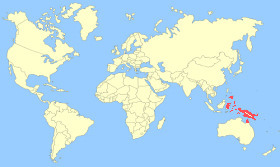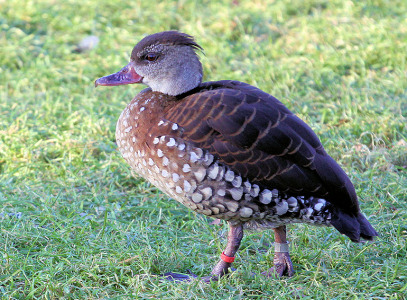Appearance: - The Spotted Whistling Duck has a grey head with a dark crown and hind neck, dark-brown eyes, a pink-grey beak, a chestnut-brown breast with small white spots, brown flanks with large white spots, underparts are whitish. Upperparts and tail are dark-brown, wings are dark-brown, and legs are reddish-grey. Both sexes are alike.
Size: - Typical Adult is 43-50cm (17-19in).
Food: - Grazes on grasses, aquatic plants, shoots, stems, seeds, leaves, also insects, snails, and frogs.
Habitat/Range: - Lakes, pools, marshes, and freshwater swamps in southern Philippines, Indonesia, New Guinea, and recently into Australia.

 Breeding Habitat/Resident,
Breeding Habitat/Resident,  Migration or Winter Area.
Migration or Winter Area.Breeding Season: - Starting in September (rainy season).
Eggs: - approx. 11 (white colour).
Notes: - The Spotted Whistling Duck is one of the larger Whistling Ducks and is sometimes called the Spotted Tree Duck. They nest in tree cavities and like to roost in trees overlooking the water. Like other Whistling Ducks they have a distinctive whistling call.
Conservation status (IUCN 3.1):
Least Concern.
Classification: - Family: Anatidae,
Subfamily: Dendrocygninae,
Genus: Dendrocygna.

































